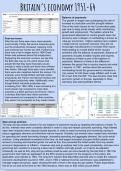Summary
Summary of economics in Britain, Oxford AQA History: A Level and AS Component 2: The Making of Modern Britain - Depth Study
- Module
- Depth Study
- Institution
- AQA
a simple and easy-to-read poster detailing all key information about the economic landscape of britain in the 1950s and 60s. All information has been checked by the head of the history department, who confirmed that all information is relevant and brilliant to use in an essay or your exam!
[Show more]




